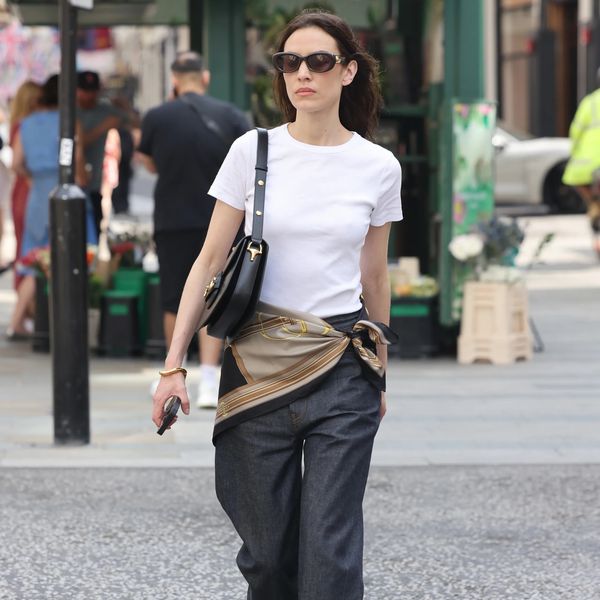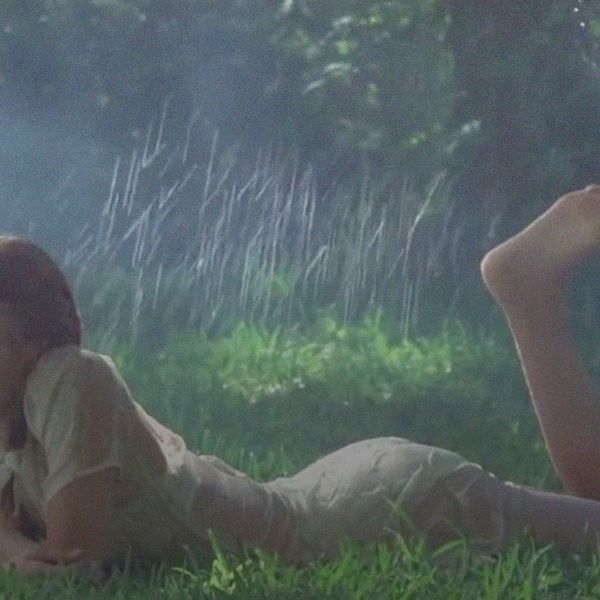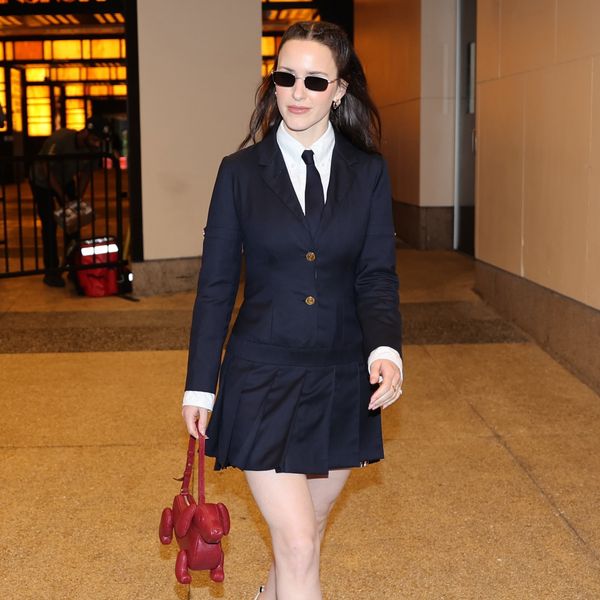Hair
White America Ruined My Hairline
A writer shares her journey to embracing her hair and finding herself.

18 August, 2020
10 November, 2021
Ever since I was eight years old, I spent most Saturdays at the hair salon. Before big events, gymnastics competitions, church plays, or graduations, I would find myself in the salon chair getting a perm. I was young, and my friends and schoolmates all had straight hair, and I didn’t want to be left out. As I grew older, I began to notice a conflict stirring within me—I wanted my hair to look like something it wasn’t meant to. I wanted bone-straight locks and the ease they offer to get up and go without having to think twice about your hair.
But I quickly realized that the world around me wasn’t made for my texture. During summer parties, I couldn’t just hop in the pool to swim with friends—I had to wear a swimming cap and avoid going underwater, or else it would ruin my perm (and it cost a pretty penny to get one). If I got my hair styled in a slicked-back ponytail, that was it; that was the style it would be in for a few weeks. There was no pulling out the hair tie and letting my hair hang—it had too much product in it.
And don’t get me started on the hair-care products that I had to use because at that time, brands were not checking for my coils and kinks. Anytime I saw my curls forming at the root, I would immediately go for a straightener or push up my hair appointments. This feeling of inadequacy only grew as I became a teenager, and there were still too few people around my hometown who looked like me, not to mention in art, movies, and music.
When I was 18, I moved to New York City to attend college. I was in a new city and around a group of people who had a sense of that freedom and self-love for which I was searching. I realized I didn’t know how to truly love myself because I couldn’t see myself. I could only see the shell of what the white normative wanted and molded me to be.
After 10 years of chemically processing my hair, I began to notice my hairline was receding on the sides of my forehead. This is called “the Vs”—it’s the widow’s peak you were never meant to have, and it happens when your hairline is continually damaged. Now, I’m not against perms for other people, nor do I condemn anyone for getting a perm; however, with the recent civil rights unrest, I was struck by how many of us start this process and eventually (sometimes unknowingly) go down the rabbit hole.
As college progressed and interviews for internships and jobs began, I knew that I needed to look the part because even though I was smart, a hard worker, and qualified for the positions I was interviewing for, I knew that my first qualifier was that I am Black. This meant all my other attributes came second. I had to look the part so as not stand out, and that meant my hair had to follow suit. I feared not being considered for roles if I didn’t look as close to my white counterparts as possible.
Knowing who I am and what I have achieved isn’t enough when I’m still seen as a representation of someone else’s subconscious or apparent beliefs that my Blackness meant that I am loud, careless, or discordant.
But I quickly realized that the world around me wasn’t made for my texture. During summer parties, I couldn’t just hop in the pool to swim with friends—I had to wear a swimming cap and avoid going underwater, or else it would ruin my perm (and it cost a pretty penny to get one). If I got my hair styled in a slicked-back ponytail, that was it; that was the style it would be in for a few weeks. There was no pulling out the hair tie and letting my hair hang—it had too much product in it.
And don’t get me started on the hair-care products that I had to use because at that time, brands were not checking for my coils and kinks. Anytime I saw my curls forming at the root, I would immediately go for a straightener or push up my hair appointments. This feeling of inadequacy only grew as I became a teenager, and there were still too few people around my hometown who looked like me, not to mention in art, movies, and music.
When I was 18, I moved to New York City to attend college. I was in a new city and around a group of people who had a sense of that freedom and self-love for which I was searching. I realized I didn’t know how to truly love myself because I couldn’t see myself. I could only see the shell of what the white normative wanted and molded me to be.
After 10 years of chemically processing my hair, I began to notice my hairline was receding on the sides of my forehead. This is called “the Vs”—it’s the widow’s peak you were never meant to have, and it happens when your hairline is continually damaged. Now, I’m not against perms for other people, nor do I condemn anyone for getting a perm; however, with the recent civil rights unrest, I was struck by how many of us start this process and eventually (sometimes unknowingly) go down the rabbit hole.
As college progressed and interviews for internships and jobs began, I knew that I needed to look the part because even though I was smart, a hard worker, and qualified for the positions I was interviewing for, I knew that my first qualifier was that I am Black. This meant all my other attributes came second. I had to look the part so as not stand out, and that meant my hair had to follow suit. I feared not being considered for roles if I didn’t look as close to my white counterparts as possible.
Knowing who I am and what I have achieved isn’t enough when I’m still seen as a representation of someone else’s subconscious or apparent beliefs that my Blackness meant that I am loud, careless, or discordant.
 Photo: Courtesy of Chelsea March
Photo: Courtesy of Chelsea March
Finally, I was starting to discover my true sense of self after finding a thriving and beautiful Black community. I decided it was time to be exactly who I was created to be, and for that to happen, that meant it was time for the big chop. If you haven’t heard of this phrase before, the big chop is when you cut off all the straight, chemically treated hair at the place where it meets your curly, natural hair.
YouTube natural hair tutorials became my other teachers as I entered into what felt like a whole new world while at college. I learned what a TWA is (a Teeny Weeny Afro), how to wash-n-go, deep-conditioning practices, and a slew of all-natural ingredients that I had in my kitchen that would benefit my hair health. All the while I watched my self-love grow. My fears of being seen as different or that I was trying to stand out weren’t gone, but I could feel the newfound freedom take over and stamp out those fears little by little.
By the time I was in my early 20s, the natural hair movement really took off in New York City. All around me I finally saw people who had hair like me, proudly letting their kinks, curls, locs, and waves fly free. I began to gain the self-love that was stripped away from me as a child growing up in white America. While I was loving the progress I was making, my hairline was still struggling. After years and years of chemical damage, it hadn’t grown back as strong or at all like the rest of my hair. I began to research ways to kick-start hair growth, trying an endless stream of supplements, creams, serums, and oils while also keeping my routine free of any harsh chemicals.
Years later I’ve finally found a concoction that works for me. To start, the simplest habit I’ve adopted is upping my water intake to 101 ounces per day. Just like a plant, your hair needs water to grow. Water supports the vitamins that we gain from food, and it strengthens your hair from the inside out—not to mention it will help clear your skin and make you glow. I knew that if I was going to increase my water intake consistently, that I would need a bottle on my person at all times. The Purist Collective Founder bottle comes with a handle, is leakproof, and is lined with shatterproof glass, so you can put anything inside it and it won't transfer flavors. I'd bring it with me from room to room and out on errands to help remind me to drink more water throughout the day.
I’ve also finally found a product that works for me—the Activating Serum from Collective Laboratories. It’s clean, vegan, and sulfate- and paraben-free, plus it’s chock-full of growth-encouraging ingredients like biotin and lilac stem cells (which help to repair strand damage and reduce scalp irritation), ginseng root to stimulate scalp microcirculation, and burdock root to moisturize. There’s also Malabar Kino Bark, which has antifungal, antimicrobial, and astringent properties to balance scalp oil. To my surprise, after about a month and a half of regular use, I started to see tiny little baby hairs pop up at my hairline. The brand is also launching a shampoo and conditioner in September to pair with the serum to help kick-start the hair-growth process, and let me tell you—it’s good!
With the world finally giving true focus to the centuries of civil injustice in our society, I couldn’t be prouder to own and love my natural hair. For me, my hair is not just the curls that grow out of my head—it is a badge of honor that I get to wear every day. It represents my roots and all of my ancestors who worked and died for me to be here, and I hope I am making them proud. To my fellow Black community, please always wear your Blackness with pride and love—we are so beautiful.
Top photo: Courtesy of Instagram/@chelseadmarch
Want more stories like this?
Expert Tips for the Best Curls of Your Life
5 Black-Owned Hair Brands You Need to Know
The 9 Best Hair Gels for Waves and Curls—Minus the Crunch
YouTube natural hair tutorials became my other teachers as I entered into what felt like a whole new world while at college. I learned what a TWA is (a Teeny Weeny Afro), how to wash-n-go, deep-conditioning practices, and a slew of all-natural ingredients that I had in my kitchen that would benefit my hair health. All the while I watched my self-love grow. My fears of being seen as different or that I was trying to stand out weren’t gone, but I could feel the newfound freedom take over and stamp out those fears little by little.
By the time I was in my early 20s, the natural hair movement really took off in New York City. All around me I finally saw people who had hair like me, proudly letting their kinks, curls, locs, and waves fly free. I began to gain the self-love that was stripped away from me as a child growing up in white America. While I was loving the progress I was making, my hairline was still struggling. After years and years of chemical damage, it hadn’t grown back as strong or at all like the rest of my hair. I began to research ways to kick-start hair growth, trying an endless stream of supplements, creams, serums, and oils while also keeping my routine free of any harsh chemicals.
Years later I’ve finally found a concoction that works for me. To start, the simplest habit I’ve adopted is upping my water intake to 101 ounces per day. Just like a plant, your hair needs water to grow. Water supports the vitamins that we gain from food, and it strengthens your hair from the inside out—not to mention it will help clear your skin and make you glow. I knew that if I was going to increase my water intake consistently, that I would need a bottle on my person at all times. The Purist Collective Founder bottle comes with a handle, is leakproof, and is lined with shatterproof glass, so you can put anything inside it and it won't transfer flavors. I'd bring it with me from room to room and out on errands to help remind me to drink more water throughout the day.
I’ve also finally found a product that works for me—the Activating Serum from Collective Laboratories. It’s clean, vegan, and sulfate- and paraben-free, plus it’s chock-full of growth-encouraging ingredients like biotin and lilac stem cells (which help to repair strand damage and reduce scalp irritation), ginseng root to stimulate scalp microcirculation, and burdock root to moisturize. There’s also Malabar Kino Bark, which has antifungal, antimicrobial, and astringent properties to balance scalp oil. To my surprise, after about a month and a half of regular use, I started to see tiny little baby hairs pop up at my hairline. The brand is also launching a shampoo and conditioner in September to pair with the serum to help kick-start the hair-growth process, and let me tell you—it’s good!
With the world finally giving true focus to the centuries of civil injustice in our society, I couldn’t be prouder to own and love my natural hair. For me, my hair is not just the curls that grow out of my head—it is a badge of honor that I get to wear every day. It represents my roots and all of my ancestors who worked and died for me to be here, and I hope I am making them proud. To my fellow Black community, please always wear your Blackness with pride and love—we are so beautiful.
Top photo: Courtesy of Instagram/@chelseadmarch
Want more stories like this?
Expert Tips for the Best Curls of Your Life
5 Black-Owned Hair Brands You Need to Know
The 9 Best Hair Gels for Waves and Curls—Minus the Crunch




